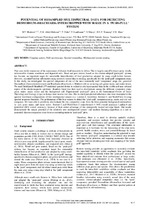| dc.description.abstract | Poor crop yields remain one of the main causes of chronic food insecurity in Africa. This is largely caused by insect pests, weeds, unfavourable climatic conditions and degraded soils. Weed and pest control, based on the climate-adapted ‘push-pull’ system, has become an important target for sustainable intensification of food production adopted by many small-holder farmers. However, essential baseline information using remotely sensed data is missing, specifically for the ‘push-pull’ companion crops. In this study, we investigated the spectral uniqueness of two of the most commonly used ‘companion’ crops (i.e. greenleaf Desmodium (Desmodium intortum) and Brachiaria (Brachiaria cv Mulato) with co-occurring soil, green maize, and maize stover. We used FieldSpec® Handheld 2™ analytical spectral device to collect in situ hyperspectral data in the visible and near-infrared region of the electromagnetic spectrum. Random forest was then used to discriminate among the different companion crops, green maize, maize stover and the background soil. Experimental ‘push-pull’ plots at the International Centre of Insect Physiology and Ecology (icipe) in Kenya were used as test sites. The in-situ hyperspectral reflectance data were resampled to the spectral waveband configurations of four multispectral sensors (i.e. Landsat-8, Quickbird, Sentinel-2, and WorldView-2) using spectral response functions. The performance of the four sensors to detect the ‘push-pull’ companion crops, maize and soil was compared. We were able to positively discriminate the two companion crops from the three potential background endmembers i.e. soil, green maize, and maize stover. Sentinel-2 and WorldView-2 outperformed (> 98% overall accuracy) Landsat-8 and Quickbird (96% overall accuracy), because of their added advantage of the strategically located red-edge bands. Our results demonstrated the unique potential of the relatively new multispectral sensors’ and machine learning algorithms as a tool to accurately discern companion crops from co-occurring maize in ‘push-pull’ plots. | en_US |

